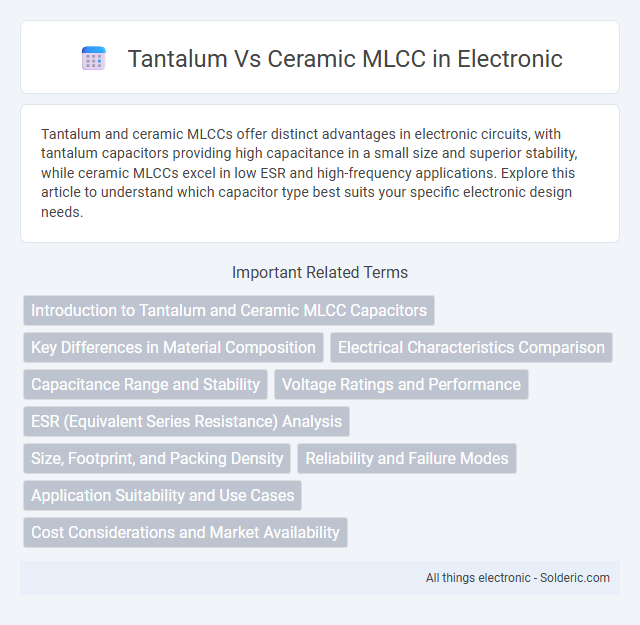Tantalum and ceramic MLCCs offer distinct advantages in electronic circuits, with tantalum capacitors providing high capacitance in a small size and superior stability, while ceramic MLCCs excel in low ESR and high-frequency applications. Explore this article to understand which capacitor type best suits your specific electronic design needs.
Comparison Table
| Feature | Tantalum Capacitors | Ceramic MLCC (Multi-Layer Ceramic Capacitors) |
|---|---|---|
| Dielectric Material | Tantalum Oxide | Barium Titanate or similar ceramics |
| Capacitance Range | 0.1 uF to 470 uF | 0.1 pF to 100 uF |
| Voltage Rating | Up to 50 V | Up to 500 V |
| Size | Generally larger for same capacitance | Compact, smallest SMD sizes available |
| Equivalent Series Resistance (ESR) | Low ESR, stable under load | Very low ESR, but varies with class |
| Reliability | Sensitive to surge currents, potential for failure if not properly derated | Generally reliable, but piezoelectric effect can cause microphonic noise |
| Temperature Stability | Moderate, stable over operating temperature range | Varies by ceramic class (X7R, C0G, etc.), C0G highly stable |
| Application | Power supply filtering, decoupling, and audio circuits | Wide range: decoupling, filtering, high-frequency applications |
| Cost | Higher per uF compared to ceramic | Lower cost, especially for small capacitance |
Introduction to Tantalum and Ceramic MLCC Capacitors
Tantalum and ceramic MLCC capacitors differ primarily in materials and performance characteristics, with tantalum capacitors using tantalum metal powder for superior volumetric efficiency and stable capacitance. Ceramic MLCCs are composed of multilayered ceramic dielectrics offering high-frequency performance and low equivalent series resistance (ESR). Your choice depends on application requirements such as capacitance value, voltage rating, and temperature stability.
Key Differences in Material Composition
Tantalum MLCCs utilize tantalum metal powder as the anode material, offering high capacitance in a compact size due to its excellent permittivity and stable electrochemical properties. Ceramic MLCCs are made from multilayer ceramic dielectric materials such as barium titanate, providing high volumetric capacitance, high insulation resistance, and temperature stability. The fundamental difference lies in tantalum's metal-based electrolyte and ceramic's inorganic dielectric layers, which influence performance characteristics like reliability, temperature coefficient, and frequency response.
Electrical Characteristics Comparison
Tantalum capacitors exhibit high capacitance per volume, stable electrical characteristics, and low equivalent series resistance (ESR), making them ideal for low-voltage, high-reliability applications. Ceramic MLCCs offer lower leakage current, higher voltage ratings, and superior frequency response due to their non-polarized nature and ceramic dielectric material. The choice depends on specific electrical requirements such as capacitance tolerance, voltage, frequency range, and reliability under temperature variations.
Capacitance Range and Stability
Tantalum capacitors typically offer capacitance values ranging from 0.1 uF to several hundred microfarads, providing high volumetric efficiency and excellent stability over temperature and time. Ceramic MLCCs (Multilayer Ceramic Capacitors) generally cover a broader capacitance range from a few picofarads up to 100 uF, with X7R and C0G/NP0 types demonstrating superior stability and low dielectric loss. The stability of ceramic MLCCs is often temperature-class dependent, with C0G/NP0 capacitors showing minimal capacitance variation, while tantalum capacitors maintain stable performance but may exhibit higher ESR compared to ceramic types.
Voltage Ratings and Performance
Tantalum MLCCs typically offer higher voltage ratings ranging from 6.3V up to 50V, making them suitable for applications requiring stable capacitance under high voltages. Ceramic MLCCs, especially Class II and III types, can handle voltages up to several hundred volts but may exhibit capacitance variation with temperature and voltage stress. Your choice between tantalum and ceramic MLCC capacitors should consider voltage requirements and performance consistency under varying electrical conditions.
ESR (Equivalent Series Resistance) Analysis
Tantalum capacitors generally exhibit higher Equivalent Series Resistance (ESR) compared to ceramic MLCCs, impacting their performance in high-frequency applications. The low ESR of ceramic MLCCs contributes to better efficiency and reduced heat generation in power supply circuits. Understanding the ESR characteristics of both capacitor types allows you to optimize your design for improved stability and thermal management.
Size, Footprint, and Packing Density
Tantalum capacitors generally have a larger size and footprint compared to ceramic MLCCs, which excel in miniaturization and high packing density. Ceramic MLCCs can be produced in much smaller case sizes, allowing for more components per unit area on printed circuit boards, optimizing space for compact electronic designs. Your choice depends on the PCB space constraints and the need for high capacitance values within minimal footprints.
Reliability and Failure Modes
Tantalum MLCCs offer high capacitance stability and excellent performance under high temperature and voltage stress but are more prone to catastrophic failures such as short circuits due to dielectric degradation. Ceramic MLCCs, especially Class II and III types, provide superior reliability in terms of resistance to aging and moisture, with failure modes typically involving cracking or gradual capacitance loss rather than sudden failure. Your choice depends on application needs, as ceramic MLCCs are favored for robust longevity, while tantalum capacitors excel in stable electrical performance but require careful derating to mitigate failure risks.
Application Suitability and Use Cases
Tantalum capacitors excel in applications requiring high capacitance in a compact size, making them ideal for power supply filtering and audio equipment. Ceramic MLCCs offer superior high-frequency performance and stability, commonly used in RF circuits, decoupling, and consumer electronics. Your choice depends on the specific electrical environment and performance requirements of the device.
Cost Considerations and Market Availability
Tantalum capacitors generally have higher costs due to their complex manufacturing processes and reliance on rare metal resources compared to ceramic MLCCs, which benefit from mass production and abundant raw materials. Ceramic MLCCs dominate the market with widespread availability and cost-effectiveness, especially in large-scale consumer electronics applications. Market trends indicate continued price competitiveness of ceramic MLCCs, while tantalum capacitors remain preferred in specialized, high-reliability sectors despite limited supply chain flexibility.
Tantalum vs ceramic MLCC Infographic

 solderic.com
solderic.com